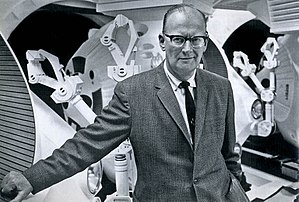Innovate Like Sir Arthur C Clarke – An Optimistic Look at the Future
 Last month I wrote about some classic innovation insights borrowed from the legendary Isaac Asimov. This month I would like to share some similar insights derived from the writings of the equally legendary Sir Arthur C Clarke, the author behind the brilliant Stanley Kubric movie 2001: A Space Odyssey, and a prolific author of quality, ‘hard’ science fiction.
Last month I wrote about some classic innovation insights borrowed from the legendary Isaac Asimov. This month I would like to share some similar insights derived from the writings of the equally legendary Sir Arthur C Clarke, the author behind the brilliant Stanley Kubric movie 2001: A Space Odyssey, and a prolific author of quality, ‘hard’ science fiction.
A Common Challenge: Why the interest in science fiction writers? Well firstly, innovators and science fiction writers share a common challenge – to envision and create the future. Of course, accurately predicting the future is an impossible task. Virtually any predictive model, even one based in hard science, will be wrong, at least to some degree. And the more complex the system we are modeling, the more wrong we are likely to be. But despite that, if we look at the big picture, and aren’t too fussy about timelines, science fiction has done a remarkably good job of predicting, and in many cases influencing, our future. For example, authors such as Douglas Adams, William Gibson, Mark Twain, and indeed Isaac Asimov were among many who predicted the internet.  And while we may not be beaming down to a planet’s surface, or leaping at warp speed through hyper space quite yet, Star Trek predicted tablets, voice activated computers, flip phones, virtual reality, hands free phones, universal translators, digitized medical biometrics, AI and 3D printing. Indeed, by envisioning them, it’s quite likely that Star Trek probably influenced their development –I know a few Silicon Valley innovators who are closet Trekkies!
A Vision of the Future:  This may sound a little trivial, but without some vision of the future, we cannot hope to help create it. And creating the future is ultimately what innovation is all about. And that brings me to Sir Arthur C Clarke. He not only wrote a significant number of Sci-Fi books, but like many sci-fi authors, including Fred Hoyle, who coined the term ‘Big Bang’, and Asimov, who held a PhD in biochemistry, he was also a respected scientist in his own right. He worked on the Royal Air Force’s early warning radar during WW-II, and was the father of the concept of satellite telecommunication relays. He published his paper on this technology in 1945, but it still touches almost every part of our lives, via communications relays, weather forecasting, and satellite TV. The geostationary orbit we use today is known as the Clarke orbit in his honor, a testament to his ability to envisage and influence the future.
Given this, it is perhaps not surprising that as with Asimov, Clarke thought seriously about innovation and the future. He actually proposed three laws, not to be confused with Asimovs’s three laws of robotics, which I believe remain insightful and instructive today for those of us who practice innovation.
1) When a distinguished but elderly scientist states that something is possible, he is almost certainly right. When he states that something is impossible, he is very probably wrong.  My take on this for innovation teams is that experience is both a blessing and a curse. To paraphrase Max Planck, science proceeds one funeral at a time, and indeed the ‘we tried that and it didn’t work’ mantra from crusty old innovators can be frustrating for those eager to explore what for them is a new space. But understanding and learning from past failures can also save a lot of wasted time, and what is obvious in hindsight is not always obvious at first glance. This begs for us to have a mixture of youth and experience on any innovation team. Youth to challenge givens and make connections to new insights that may have emerged elsewhere since the last time an approach was tried. But youth tempered with experience to avoid reinventing the wheel, or to keep climbing the same hill, Sisyphus-like, as every new generation of innovators sees the same relatively obvious approach to a tenacious problem, but hits the same killer issue hidden down the same well trodden path. We should never be afraid to challenge givens, or revisit old ideas in light of new data, enabling technology, or simple shifts in consumer needs. Sometimes consumers simply need to catch up with the vision of innovators. Nowhere is that more apparent than in environmentally responsible innovation. But key to this is being informed about past failures, not blissfully unaware of them, and/or to have at least a hypothesis as to what has changed to make it worthwhile revisiting an old idea.  This means not only having a mix of experience within an innovation organization, but also making sure that individual teams have sufficient age and experience diversity, and/or that organizations retain sufficient experience, and leverage it sufficiently early in the innovation process. There is little worse than having a senior manager tell you they could have saved you a year’s work, because they went through the same challenge many years ago, but only telling after you have spent considerable energy rediscovering that same painful insight for yourself.
2) The only way of discovering the limits of the possible is to venture a little way past them into the impossible.  As innovators we need to embrace the impossible, but also be realistic enough to quickly recognize and communicate the limitations of our ideas. The key here is balance. I had one boss who would take our proof of concept experiments, and then sell them to his manager along with unrealistic timelines, costs and technically impractical but beautiful design. He was well intentioned (I think), but it’s a tall order to transform a $20 formula in a liter bucket into 20c product that fits into your back pocket, and do so by the end of the week. Stretch goals and proof of concept experiments can be powerful enablers to delivering the almost impossible, but taken too far they can also be very demotivating, and create a divide between innovators and leadership. Balance comes most easily when leadership are also experienced innovators, who take time to deeply understand both the benefits and challenges associated with a new technology.
3) Any sufficiently advanced technology is indistinguishable from magic. This is my favorite, as it has philosophical as well as practical implications, as if we do ever encounter any advanced extraterrestrial civilizations, their technology may well appear magical or even godlike. But bringing this a bit closer to home, as innovators we should be trying to create magic. In fact, our world is full of everyday magic. My mother is 92, and when she was a girl, the idea of self-driving cars, landing on the Moon, or even a talking computer was magic, or at least, just science fiction. But someone embracing magic, and finding ways to make that magic real, has made them either part of everyday life, or at least concepts that now seem within our grasp.
And that brings me back full circle. Accurately imagining the future is impossible, but that doesn’t mean that we shouldn’t try, or that it isn’t useful. Borrowing a little bit of the science fiction writer’s optimism (or pessimism)and vision can be really powerful. And it doesn’t have to apply just to really big concepts. It’s quite hard to imagine today that the flip phone used by those early inhabitants of the Starship Enterprise was far more fiction than science. Yet today it is already outdated technology, and the truth of the I-Phone is truly stranger, and more magical than that imagined fictional flip phone of 60 years ago. Not only is our future indistinguishable from 1960’s magic, innovation has in some ways made it better than anything we imagined. In a world that today is often filled with negativity, that’s a thought I like to hang onto.
Image Credit: Wikipedia
Wait! Before you go…
Choose how you want the latest innovation content delivered to you:
- Daily — RSS Feed — Email — Twitter — Facebook — Linkedin Today
- Weekly — Email Newsletter — Free Magazine — Linkedin Group
 A twenty-five year Procter & Gamble veteran, Pete Foley has spent the last 8+ years applying insights from psychology and behavioral science to innovation, product design, and brand communication. He spent 17 years as a serial innovator, creating novel products, perfume delivery systems, cleaning technologies, devices and many other consumer-centric innovations, resulting in well over 100 granted or published patents. Follow him @foley_pete
A twenty-five year Procter & Gamble veteran, Pete Foley has spent the last 8+ years applying insights from psychology and behavioral science to innovation, product design, and brand communication. He spent 17 years as a serial innovator, creating novel products, perfume delivery systems, cleaning technologies, devices and many other consumer-centric innovations, resulting in well over 100 granted or published patents. Follow him @foley_pete
NEVER MISS ANOTHER NEWSLETTER!
LATEST BLOGS
The Incredible Shrinking Laptop
As technology advances and people’s demands for ever-thinner, ever-lighter laptops increase, more and more the thickness of a laptop is…
Read MoreA Revolution in Management Consulting?
Management consulting firms are built on a model that requires the maintenance of a bench of their people to staff…
Read More



